UNIT CIRCLE WORKSHEET
Problem 1 :
Show that the point A(4/5, -3/5) is on the unit circle.
Problem 2 :
Show that the point P(√3/3, √6/3) is on the unit circle.
Problem 3 :
The point P is on the unit circle. Find P(x, y) from the given information. The y-coordinate of P is -1/3 and the x-coordinate is positive.
Problem 4 :
If the the point P(√3/2, k) is on the unit circle in quadrant IV, find the value of k.
Problem 5 :
The point P is on the unit circle. Find P(x, y) from the given information. The x-coordinate of P is -2/5 and P lies above the x-axis.
Problem 6 :
The point P is on the unit circle. Find P(x, y) from the given information. The y-coordinate of P is -1/2 and P lies on the left side of y-axis.
Problems 7-12 : Find the terminal point on the unit circle determined by each real number t.
Problem 7 :
t = 3π
Problem 8 :
t = -π
Problem 9 :
t = -π/2
Problem 10 :
t = -π/4
Problem 11 :
t = 3π/4
Problem 12 :
t = -5π/6
Problems 13-16 : Find the reference number for each value of t.
Problem 13 :
t = 5π/6
Problem 14 :
t = 7π/4
Problem 15 :
t = -2π/3
Problem 16 :
t = 5.80
Problems 17-20 : Find the terminal point on the unit circle determined by each real number t.
Problem 17 :
t = 5π/6
Problem 18 :
t = 7π/4
Problem 19 :
t = -2π/3
Problem 20 :
t = 29π/6

Answers
1. Answer :
We have to show that this point satisfies the equation of the unit circle, that is, x2 + y2 = 1.
(4/5)2 + (-3/5)2 = 16/25 + 9/25
= (16 + 9)/25
= 25/25
= 1
So, A is on the unit circle.
2. Answer :
We have to show that this point satisfies the equation of the unit circle, that is, x2 + y2 = 1.
(√3/3)2 + (√6/3)2 = 3/9 + 6/9
= (3 + 6)/9
= 9/9
= 1
So, P is on the unit circle.
3. Answer :
Because the point is on the unit circle, we have
x2 + (-1/3)2 = 1
x2 + 1/9 = 1
Subtract 1/9 from each side.
x2 = 1 - 1/9
x2 = 9/9 - 1/9
x2 = (9 - 1)/9
x2 = 8/9
Take square root on both sides.
x = ±2√2/3
Because x-coordinate is negative,
x = 2√2/3
The point is
P(2√2/3, -1/3)
4. Answer :
Because the point is on the unit circle, we have
(√3/2)2 + k2 = 1
3/4 + k2 = 1
Subtract 3/4 from both sides.
k2 = 1 - 3/4
k2 = 4/4 - 3/4
k2 = (4 - 3)/4
k2 = 1/4
Take square root on both sides.
k = ±1/2
Because the point is in quadrant IV and k is the y-coordinate, the value of k must be negative.
So, k = -1/2.
5. Answer :
Because the point is on the unit circle, we have
(-2/5)2 + y2 = 1
4/25 + y2 = 1
Subtract 4/25 from each side.
y2 = 1 - 4/25
y2 = 25/25 - 4/25
y2 = (25 - 4)/25
y2 = 21/25
Take square root on both sides.
y = ±√21/5
Because P lies above the x-axis, y-coordinate must be positive.
y = √21/5
The point is
P(-2/5, √21/5)
6. Answer :
Because the point is on the unit circle, we have
x2 + (-1/2)2 = 1
x2 + 1/4 = 1
Subtract 1/4 from each side.
x2 = 1 - 1/4
x2 = 4/4 - 1/4
x2 = (4 - 1)/4
x2 = 3/4
Take square root on both sides.
x = ±√3/2
Because P lies on the left side of y-axis, x-coordinate must be negative.
x = -√3/2
The point is
P(-√3/2, -1/2)
7. Answer :
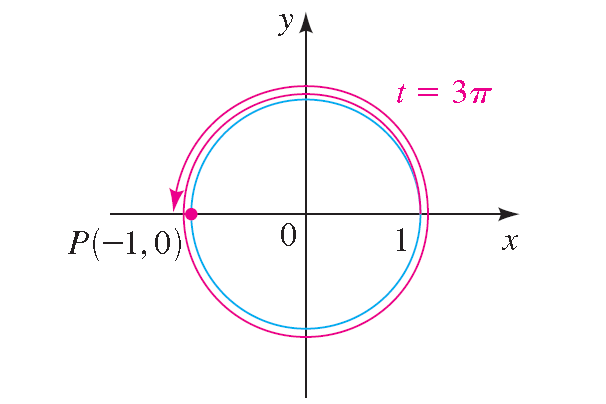
The terminal point determined by 3π is (-1, -0).
8. Answer :
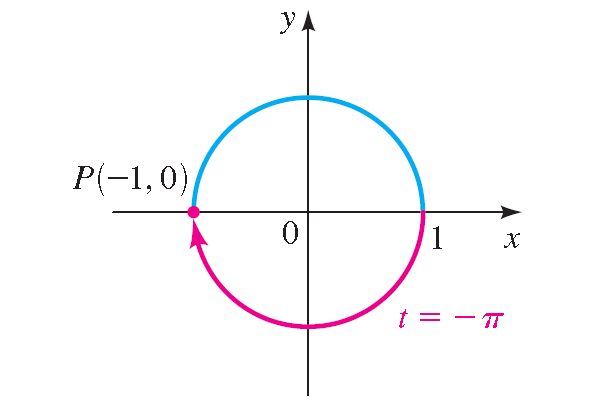
The terminal point determined by -π is (-1, -0).
9. Answer :
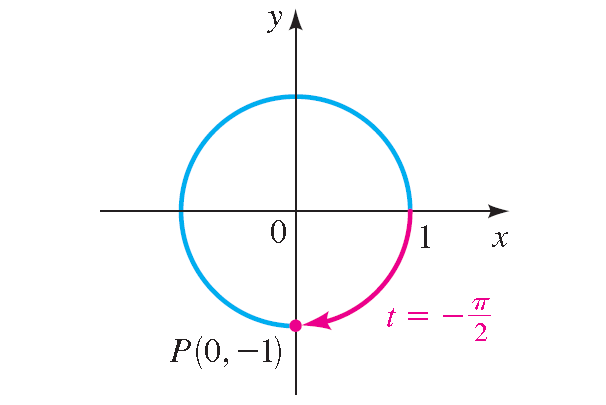
The terminal point determined by -π/2 is (0, -1).
10. Answer :
Let P be the terminal point determined by -π/4, and let Q be the terminal point determined by π/4. In the diagram shown below, we see that the point P has the same coordinates as Q except for sign.
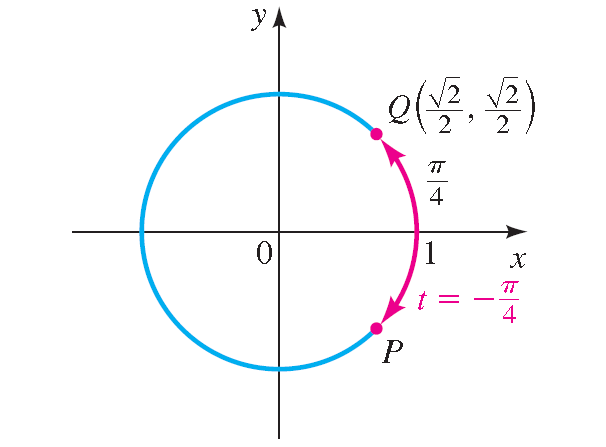
Because P is in quadrant IV, its x-coordinate is positive and its y-coordinate is negative. Thus, the terminal point is
P(√2/2, -√2/2)
11. Answer :
Let P be the terminal point determined by 3π/4, and let Q be the terminal point determined by π/4. In the diagram shown below, we see that the point P has the same coordinates as Q except for sign.
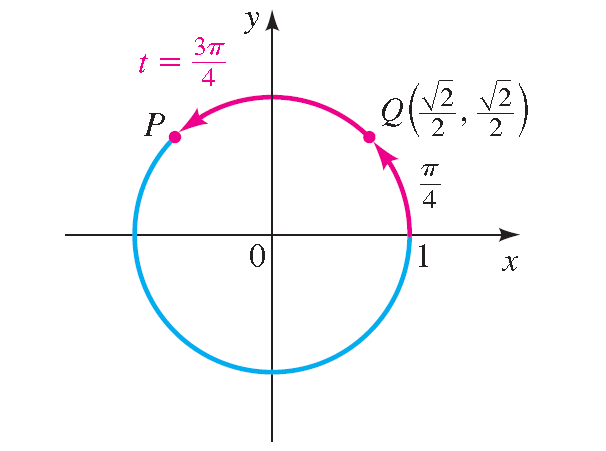
Because P is in quadrant II, its x-coordinate is negative and its y-coordinate is positive. Thus, the terminal point is
P(-√2/2, √2/2)
12. Answer :
Let P be the terminal point determined by -5π/6, and let Q be the terminal point determined by π/6. In the diagram shown below, we see that the point P has the same coordinates as Q except for sign.
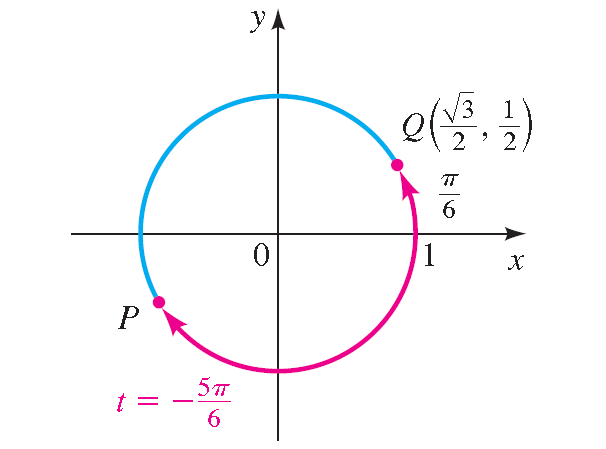
Because P is in quadrant III, its both x-coordinate and y-coordinate are negative. Thus, the terminal point is
P(-√3/2, -1/2)
13. Answer :
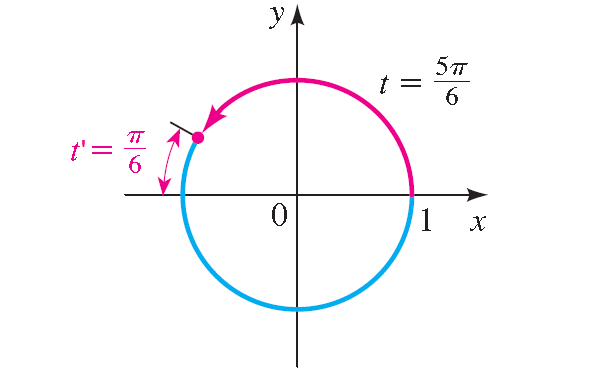
t' = π - 5π/6 = π/6
14. Answer :
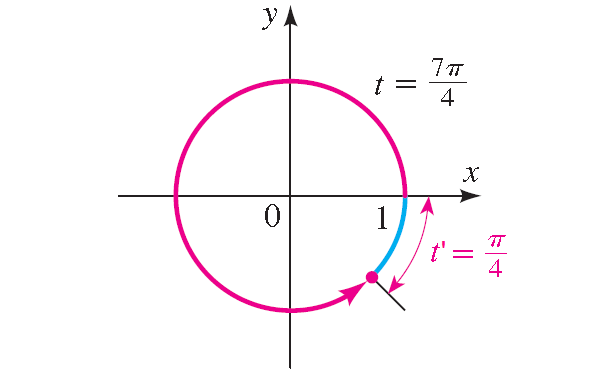
t' = 2π - 7π/4 = π/4
15. Answer :
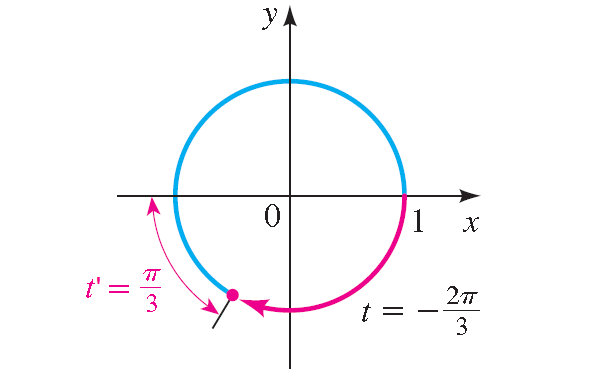
t' = π - 2π/3 = π/3
16. Answer :
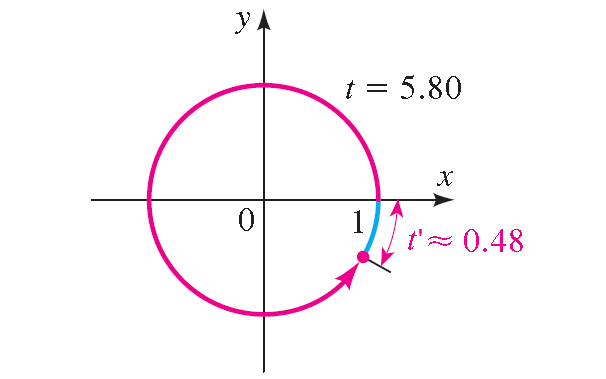
t' = 2π - 5.80 ≈ 0.48
17. Answer :
The reference numbers associated with these values of t were found in Problem 13.
The reference number is t' = π/6, which determines the terminal point (√3/2, 1/2) from the table.
Because the terminal point determined by t is in quadrant II, its x-coordinate is negative and its y-coordinate is positive. Thus, the desired terminal point is
(-√3/2, 1/2)
18. Answer :
The reference numbers associated with these values of t were found in Problem 14.
The reference number is t' = π/4, which determines the terminal point (√2/2, √2/2) from the table.
Because the terminal point is in quadrant IV, its x-coordinate is positive and its y-coordinate is negative. Thus, the desired terminal point is
(√2/2, -√2/2)
19. Answer :
The reference numbers associated with these values of t were found in Problem 15.
The reference number is t' = π/3, which determines the terminal point (1/2, √3/2) from the table.
Because the terminal point determined by t is in quadrant III, its both x-coordinate and y-coordinate are negative. Thus, the desired terminal point is
(-1/2, -√3/2)
20. Answer :
Because
t = 29π/6 = 4π + 5π/6
we see that the terminal point of t is the same as that of 5π/6 (that is, we subtract 4π).
So by Example 13 the terminal point is
(-√3/2, 1/2)
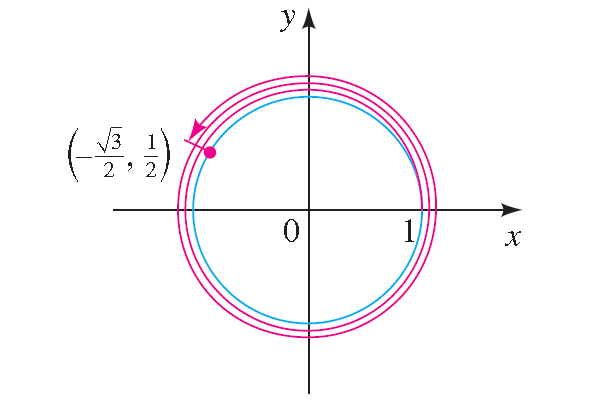
Kindly mail your feedback to v4formath@gmail.com
We always appreciate your feedback.
©All rights reserved. onlinemath4all.com
Recent Articles
-
Trigonometry Even and Odd Iidentities
May 05, 24 12:25 AM
Trigonometry Even and Odd Iidentities -
SOHCAHTOA Worksheet
May 03, 24 08:50 PM
SOHCAHTOA Worksheet -
Trigonometry Pythagorean Identities
May 02, 24 11:43 PM
Trigonometry Pythagorean Identities

